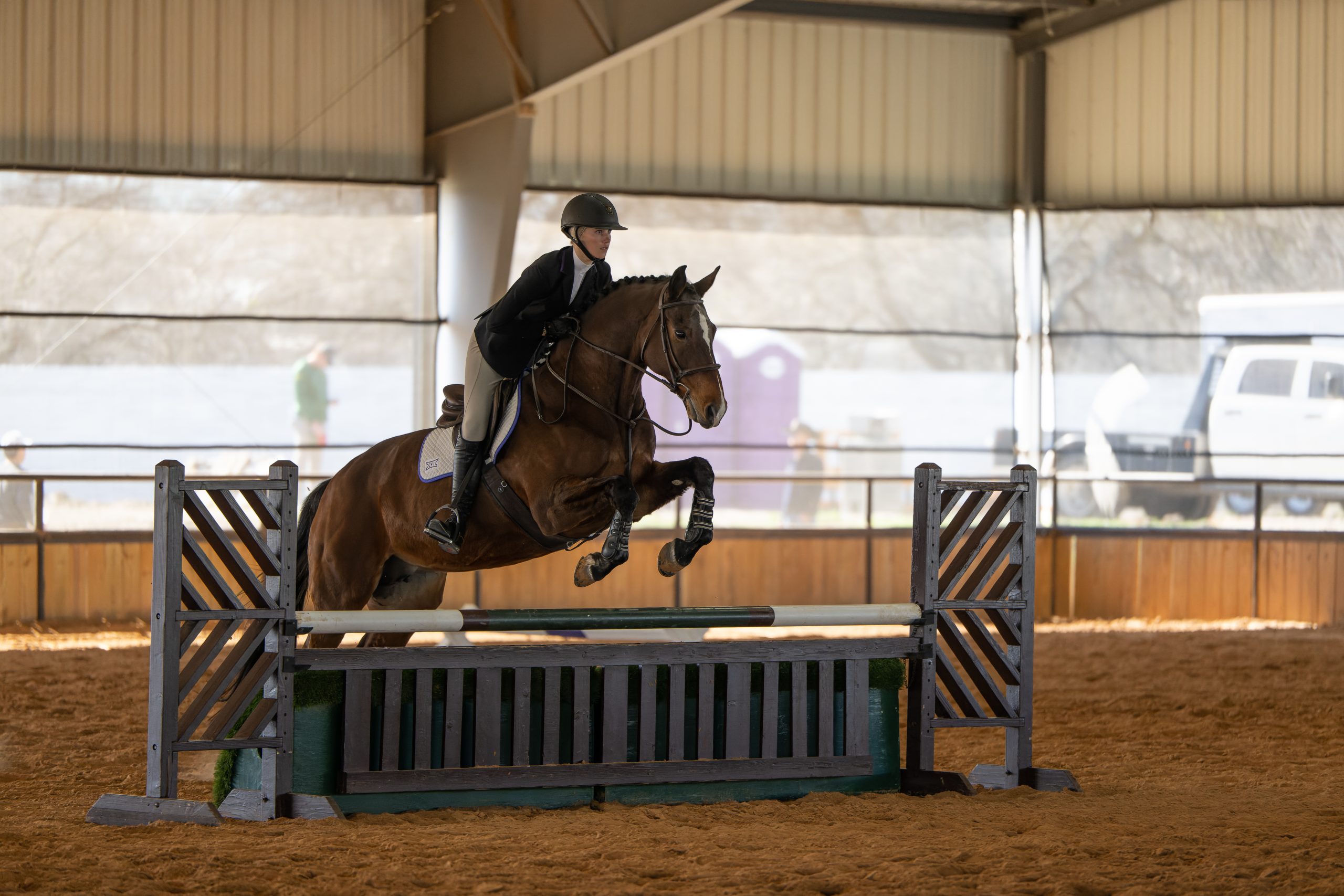Ashleigh Scully: The Wildlife Whisperer
Ashleigh Scully is an All-American student-athlete and an accomplished nature photographer.

Ashleigh Scully was named All-Big 12 Conference Rider of the Year in fences last season. The Morristown, N.J., native has also won several high-profile photography awards. Courtesy of TCU Athletics
Ashleigh Scully: The Wildlife Whisperer
Ashleigh Scully is an All-American student-athlete and an accomplished nature photographer.
Ashleigh Scully was only 15 when she presented at the London Natural History Museum’s 2017 Wildlife Photographer of the Year awards ceremony as a winner in her age division. From underneath the museum’s blue whale skeleton, surrounded by the grand pillars and vast stone staircases of the Hintze Hall gallery, Scully spoke to guests who included some of the greats in photography — Brent Stirton, Karine Aigner and Steve Winter.
“I’m just a little girl, shaking in my boots,” she said, “but constantly being in that spotlight as a kid helped me in front of a camera and knowing what to say and what to fall back on.”
Scully ’24, a first-team All-American for TCU Equestrian who’s completing her master’s in English literature, is a world-class conservation photographer. National Geographic Kids showcased her work by the time she was a tween, and her images are exhibited in former President Joe Biden’s home and at the Smithsonian National Museum of Natural History in Washington, D.C.
Scully’s first foray into photography arrived around her 8th birthday when her grandparents gave her a point-and-shoot Olympus camera. The family took a trip to Alaska later that year, which was a formative experience for Scully.
Exposure to the diversity of wildlife, particularly marine life, sparked something in her. Scully photographed everything from brown bears on a humpback whale carcass to orcas in Elfin Cove during her family’s cruise from Sitka to Juneau, Alaska.

Ashleigh Scully competes during a March 2023 match against Baylor at Burleson, Texas’s Bear Creek Farms. Photo by Michael Clements | Ellman Photography
“I’d always loved nature. My family’s always been very outdoorsy,” Scully said. “But that was the trip that solidified my passion for photography — and wildlife photography, specifically.”
Back home in the woodsy suburbs of northern New Jersey, she continued to refine her craft, her brother finding and posing various frogs, snakes and turtles for Scully to photograph.
“I just kept going. I started submitting to competitions,” Scully said. “Then, once I understood the foundation of photography as far as composition and settings and rule of thirds, I started doing well in those competitions. And it got me a lot of connections in the field.”
Inspiring Action
Scully’s photography career continued to blossom in her early teens; as her skills grew, so did her connection to conservation efforts. In 2016, she assisted a team of biologists on the Teton Cougar Project, a scientific endeavor to better understand the role mountain lions play in the southern Yellowstone ecosystem.
“They were collecting data to try and prove that they were beneficial for the ecosystem, to try and lower the hunting quota on them every year,” Scully said. “And they had antennas, and some of the cats were collared so we could track them.”
Scully’s role was to set up cameras with sight lines on a group of cougar kittens. But by the time Scully and the team had arrived, the kittens’ mother was due back at any moment.
“So we only saw this little one, and it was really tiny,” Scully said. “It had bright blue eyes and these spots. And I only had about 30 seconds to take a photo because we saw on the antenna that the mom was on her way back pretty quickly.”
By the time the London Natural History Museum honored her as a Wildlife Photographer of the Year, she had been named a finalist or semifinalist three times. Her winning image, “Stuck In,” shows a red fox burrowed head-first into the snow, the canid’s hind legs and white-tipped tail levitating against a snow-white background.
During a summer 2019 workshop in Tunbridge Wells, 40 miles southeast of London, Scully spent a month with The Fox Project, a registered charity and wildlife hospital dedicated to protecting red foxes. She continues to collaborate with Wyoming Untrapped, an organization that raises awareness of inhumane wildlife trapping and promotes trapping reform across the state.

Photographing this polar bear in Svalbard, Norway, was “one of the greatest experiences of my life,” said Ashleigh Scully, who added the bear traveled miles from land “via pack ice in search of seals and other prey.” Photo by Ashleigh Scully
In 2021, she won the North American Nature Photography Association Outstanding Young Photographer of the Year award, recognizing her body of work.
Scully has gotten involved in several conservation-related fundraising campaigns, including 100 for the Ocean, which gathers 100 esteemed photographers to support three ocean conservation groups. The event raised more than half a million dollars during its inaugural 2023 campaign, according to Colossal, an online art magazine.
“We would promote our photos online,” Scully said, “using our social media platforms to try and get people to go online and buy the print and get it framed in order to raise money.”
Scully, now 23, is aware of her effect on animals and their habitats, wrote conservation photographer and writer Melissa Groo in an email to TCU Magazine.
Groo and Scully connected more than a decade ago in an online photography forum and started a dialogue through email. To this day, Scully counts Groo among her foremost mentors; the two have photographed together in Grand Teton National Park and on a photo safari in Tanzania.

Ashleigh Scully (right) and Melissa Groo photographing owls in 2016. “I think the sky is the limit for Ashleigh if she chooses that path,” wrote Groo of her protégé’s prospects in wildlife photography. Photo by Gerry Scully
“She reads the comfort level of her subjects and adjusts her behavior accordingly,” Groo wrote. “Often, she works from blinds so that animals will be completely undisturbed.”
Scully’s arresting images have attracted 167,000 followers to her Instagram account; her photography has purpose beyond its beauty.
She is “intent on impacting conservation with her images, both through how she takes her photos, and then what she does with the images once she’s taken them,” Groo wrote. “Conservation photography is a genre of wildlife photography that really focuses on highlighting species and the habitats critical to their survival.”
All-American Equestrian
Scully’s interest in animals began even before her introduction to photography. Her mother, who rode in her homeland of Germany before immigrating to the United States, headed down the Scullys’ New Jersey street on horseback daily. “She was always dressed up to go to lessons,” Scully said.
Scully was riding horses herself by age 4.
“I’m the oldest of three, so I was always looking up to my parents,” Scully said. “One day, I asked if I could take a lesson, and I never stopped.”
Scully said the prospect of riding in college came into focus during her first year of high school, a time at which, she said, “riding was my entire life.”
“I’m the oldest of three, so I was always looking up to my parents. One day, I asked if I could take a lesson, and I never stopped.”
Ashleigh Scully
“I would go to the barn every single day after school,” Scully said. “And then I would go show over the weekend, or I’d be flying back and forth to Florida every weekend for like four months to compete.”
When Scully’s abilities brought her to TCU’s campus for a tour, she made an impression. She was initially scheduled to meet with the equestrian team’s head jumping seat coach, Logan Fiorentino, for 45 minutes on an unofficial visit; their conversation stretched to two hours.
“I was just impressed by her story,” Fiorentino said, referring to Scully’s myriad pursuits. “Her athletic abilities are very apparent. She was a little raw in talent at the time, but I have always believed that interesting people make interesting teams, and she was a really interesting person.”
Scully found her way as a collegiate rider with characteristics Fiorentino calls emblematic of many a successful athlete: consistency, reliability and attention to detail. She’s become a senior stateswoman for the equestrian team, which this season entered the year ranked No. 1 in the nation for the first time in program history.
“There’s a confidence as a team when you walk in and you have teammates like her,” Fiorentino said. “And she’s not the only one on the team that brings these qualities. This group has spent a lot of time together over the last three years.”
Natural Leader
Scully earned NCEA All-Academic first-team recognition each of the last three years and NCEA first-team All-American and All-Big 12 Conference Rider of the Year honors in fences last season.
Voted one of the equestrian team’s four captains for this 2024-25 campaign, Scully has transformed into a program leader through her success and dedication to the sport, said Haley Schoolfield, director of equestrian at TCU.
“She’s a person who’s not afraid to help her teammates,” Schoolfield said, “and she’s not afraid to hold her teammates accountable.”
Scully’s innate understanding of animal behavior impacts her careers, artistic and athletic.
“She can read horses,” Schoolfield said. “She can read tracks better than anyone I have ever observed, and do it quickly and then state it eloquently, whether it’s to her benefit or her teammates’.”

Ashleigh Scully is a diehard Yankees fan, here watching Aaron Judge launch his American League record 62nd home run of the 2022 season. Courtesy of Ashleigh Scully
Scully said her three greatest callings in life are riding, photography and writing. Her dream is to be a writer and photojournalist.
“You have to always place the welfare of the animal before the shot; she embodies that,” Groo wrote. “I think she could do it all — she could teach photography, write articles, go on assignments for magazines, tell conservation stories of endangered species or places, publish books. I really see no limit.”
Groo, like Scully, majored in English in college. She said the ability to write — whether a clear and educational caption for a photo on social media or writing an article for a magazine — makes Scully more versatile and marketable.
“For this generation, it’s easy to fall into the ‘ums’ and the ‘likes,’ and not being comfortable standing in front of a classroom and talking to their peers,” Scully said. “But [studying English literature] made me confident in my ability to use words and craft them in my mind in different ways. It’s mostly important as far as storytelling, which is my job as a photographer.”

Your comments are welcome
Comments
Related reading:
Features
How Equestrian Competition Works
Horseplay: Game Day Logistics. TCU and other schools face off for points in four equestrian events.
Features
Passing on the Outside
Race car driver Maddie Aust is a humble trailblazer.
Features
TCU Horses Bring Personalities to Competitions
Not just a horse, of course – equine-athletes are the stars of the stable at equestrian events.